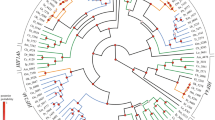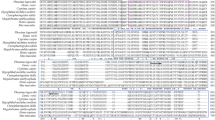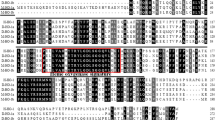Abstract
Cetaceans have evolved many behavioral and biological adaptations to allow them to survive in aquatic environments. Because of diving and breath-holding behaviors, cetaceans experience wide fluctuations in oxygen tension. However, the molecular basis behind their adaptation to a wide range of diving depths and durations remains unknown. Hypoxia-inducible factor (HIF) is a crucial regulator of cellular and systemic responses to low oxygen levels. In this study, the HIF-1α gene was cloned from the sperm whale (Physeter macrocephalus), the beluga whale (Delphinapterus leucas), and the Yangtze finless porpoise (Neophocaena asiaeorientalis asiaeorientalis). HIF-1α from the deep-diving sperm whale degraded rapidly under normoxia but remained stable during hypoxia compared with HIF-1α from the beluga whale and the Yangtze finless porpoise. Sperm whale HIF-1α also responded to reoxygenation significantly faster and exerted more potent effects on the transcriptional activity of some gene promoters compared with HIF-1α from the beluga whale and the Yangtze finless porpoise. Mutations in HIF-1α were detected between the Yangtze finless porpoise and the sperm whale, which may determine their functional differences. The results suggest that the response of sperm whale HIF-1α to different oxygen tensions is more variable than that of Yangtze finless porpoise or beluga whale HIF-1α, indicating that the rate of degradation of HIF-1α may be more variable in long-duration divers than in short-duration diver cetaceans. Because of the lack of whale models and whale cell lines, all experiments were conducted in vitro using human embryonic kidney 293T cells.







Similar content being viewed by others
Abbreviations
- BNIP3:
-
The Bcl-2 19-kDa interacting protein
- cDNA:
-
Complementary DNA
- CHX:
-
Cycloheximide
- ENO1:
-
Non-neural enolase or α-enolase
- FIH:
-
Factor inhibiting HIF
- HIF:
-
Hypoxia-inducible factor
- HRE:
-
Hypoxia response element
- IUCN:
-
International Union for Conservation of Nature and Natural Resources
- ODD:
-
Oxygen-dependent degradation
- PHD:
-
Prolyl hydroxylase domain enzyme
- RIPA:
-
Radio immunoprecipitation assay
- RT-PCR:
-
Reverse transcription PCR
- SOD:
-
Superoxide dismutase
- TAD-N:
-
N-terminal transcriptional activation
- VHL:
-
Von Hippel–Lindau tumor suppressor
- VEGF:
-
Vascular endothelial growth factor
References
Akamatsu T, Wang D, Wang K, Wei Z, Zhao Q, Naito Y (2002) Diving behaviour of freshwater finless porpoises (Neophocaena phocaenoides) in an oxbow of the Yangtze River, China. ICES J Mar Sci J Cons 59:438–443. doi:10.1006/jmsc.2001.1159
Appelhoff RJ, Tian Y-M, Raval RR, Turley H, Harris AL, Pugh CW, Ratcliffe PJ, Gleadle JM (2004) Differential function of the prolyl hydroxylases PHD1, PHD2, and PHD3 in the regulation of hypoxia-inducible factor. J Biol Chem 279:38458–38465. doi:10.1074/jbc.M206955200
Bigham A, Bauchet M, Pinto D, Mao X, Akey JM, Mei R, Scherer SW, Julian CG, Wilson MJ, Herráez DL (2010) Identifying signatures of natural selection in Tibetan and Andean populations using dense genome scan data. PLoS Genet 6:e1001116. doi:10.1371/journal.pgen.1001116
Cantu-Medellin N, Byrd B, Hohn A, Vazquez-Medina JP, Zenteno-Savin T (2011) Differential antioxidant protection in tissues from marine mammals with distinct diving capacities. Shallow/short vs. deep/long divers. Comp Biochem Phys A 158:438–443. doi:10.1016/j.cbpa.2010.11.029
DeLong RL, Stewart BS (1991) Diving patterns of northern elephant seal bulls. Mar Mamm Sci 7:369–384. doi:10.1111/j.1748-7692.1991.tb00112.x
Epstein AC, Gleadle JM, McNeill LA, Hewitson KS, O’Rourke J, Mole DR, Mukherji M, Metzen E, Wilson MI, Dhanda A (2001) C. elegans EGL-9 and mammalian homologs define a family of dioxygenases that regulate HIF by prolyl hydroxylation. Cell 107:43–54. doi:10.1016/S0092-8674(01)00507-4
Feo S, Arcuri D, Piddini E, Passantino R, Giallongo A (2000) ENO1 gene product binds to the c-myc promoter and acts as a transcriptional repressor: relationship with Myc promoter-binding protein 1 (MBP-1). FEBS Lett 473:47–52. doi:10.1016/S0014-5793(00)01494-0
Ferrara N, Gerber H-P, LeCouter J (2003) The biology of VEGF and its receptors. Nat Med 9:669–676. doi:10.1038/nm0603-669
Gao S, Lu L, Bai Y, Zhang P, Song W, Duan C (2014) Structural and functional analysis of amphioxus HIFalpha reveals ancient features of the HIFalpha family. FASEB J 28:1880–1890. doi:10.1096/fj.12-220152
Gavin T, Drew J, Kubik C, Pofahl W, Hickner R (2007) Acute resistance exercise increases skeletal muscle angiogenic growth factor expression. Acta Physiol 191:139–146. doi:10.1111/j.1748-1716.2007.01723.x
Heide-Jørgensen M, Dietz R, Laidre K, Richard P (2002) Autumn movements, home ranges, and winter density of narwhals (Monodon monoceros) tagged in Tremblay Sound, Baffin Island. Polar Biol 25:331–341. doi:10.1007/s00300-001-0347-6
Hewitson K, McNeill L, Schofield C (2004) Modulating the hypoxia-inducible factor signaling pathway: applications from cardiovascular disease to cancer. Curr Pharm Des 10:821–833. doi:10.2174/1381612043452884
Hicklin DJ, Ellis LM (2005) Role of the vascular endothelial growth factor pathway in tumor growth and angiogenesis. J Clin Oncol 23:1011–1027. doi:10.1200/JCO.2005.06.081
Hirota K, Semenza GL (2005) Regulation of hypoxia-inducible factor 1 by prolyl and asparaginyl hydroxylases. Biochem Biophys Res Commun 338:610–616. doi:10.1016/j.bbrc.2005.08.193
Hoffman EC, Reyes H, Chu F-F, Sander F, Conley LH, Brooks BA, Hankinson O (1991) Cloning of a factor required for activity of the Ah (dioxin) receptor. Science 252:954–958. doi:10.1126/science.1852076
Höpfl G, Ogunshola O, Gassmann M (2004) HIFs and tumors—causes and consequences. Am J Physiol Reg I 286:R608–R623. doi:10.1152/ajpregu.00538.2003
Johnson P, Elsner R, Zenteno-Savín T (2004) Hypoxia-inducible factor in ringed seal (Phoca hispida) tissues. Free Radic Res 38:847–854. doi:10.1080/10715760410001725526
Johnson P, Elsner R, Zenteno-Savín T (2005) Hypoxia-inducible factor 1 proteomics and diving adaptations in ringed seal. Free Radic Biol Med 39:205–212. doi:10.1016/j.freeradbiomed.2005.03.008
Kim J-W, Dang CV (2005) Multifaceted roles of glycolytic enzymes. Trends Biochem Sci 30:142–150. doi:10.1016/j.tibs.2005.01.005
Kim J-Y, Cho J-J, Ha J, Park J-H (2002) The carboxy terminal C-tail of BNip3 is crucial in induction of mitochondrial permeability transition in isolated mitochondria. Arch Biochem Biophys 398:147–152. doi:10.1006/abbi.2001.2673
Kovacs KM, Lydersen C, Overland JE, Moore SE (2011) Impacts of changing sea–ice conditions on Arctic marine mammals. Mar Biodivers 41:181–194. doi:10.1007/s12526-010-0061-0
Lando D, Peet DJ, Gorman JJ, Whelan DA, Whitelaw ML, Bruick RK (2002) FIH-1 is an asparaginyl hydroxylase enzyme that regulates the transcriptional activity of hypoxia-inducible factor. Genes Dev 16:1466–1471. doi:10.1101/gad.991402
Laughner E, Taghavi P, Chiles K, Mahon PC, Semenza GL (2001) HER2 (neu) signaling increases the rate of hypoxia-inducible factor 1α (HIF-1α) synthesis: novel mechanism for HIF-1-mediated vascular endothelial growth factor expression. Mol Cell Biol 21:3995–4004. doi:10.1128/MCB.21.12.3995-4004.2001
Lydersen C (2014) Status and biology of ringed seals (Phoca hispida) in Svalbard. NAMMCO Sci Publ 1:46–62. doi:10.7557/3.2980
Mazzone M, Dettori D, Leite de Oliveira R, Loges S, Schmidt T, Jonckx B, Tian Y-M, Lanahan AA, Pollard P, Ruiz de Almodovar C (2009) Heterozygous deficiency of PHD2 restores tumor oxygenation and inhibits metastasis via endothelial normalization. Cell 136:839–851. doi:10.1016/j.cell.2009.01.020
Meir JU, Ponganis PJ (2010) Blood temperature profiles of diving elephant seals. Physiol Biochem Zool 83:531–540. doi:10.1086/651070
Meir JU, Champagne CD, Costa DP, Williams CL, Ponganis PJ (2009) Extreme hypoxemic tolerance and blood oxygen depletion in diving elephant seals. Am J Physiol Reg I 297:R927–R939. doi:10.1152/ajpregu.00247.2009
Noren SR, Williams TM (2000) Body size and skeletal muscle myoglobin of cetaceans: adaptations for maximizing dive duration. Comp Biochem Phys A 126:181–191. doi:10.1016/S1095-6433(00)00182-3
Polasek L, Dickson K, Davis R (2006) Metabolic indicators in the skeletal muscles of harbor seals (Phoca vitulina). Am J Physiol Reg I 290:R1720–R1727. doi:10.1152/ajpregu.00080.2005
Ponganis PJ (2011) Diving mammals. Comp Physiol 1:447–465. doi:10.1002/cphy.c091003
Pugh CW, Ratcliffe PJ (2003) Regulation of angiogenesis by hypoxia: role of the HIF system. Nat Med 9:677–684. doi:10.1038/nm0603-677
Rahman MS, Thomas P (2007) Molecular cloning, characterization and expression of two hypoxia-inducible factor alpha subunits, HIF-1alpha and HIF-2alpha, in a hypoxia-tolerant marine teleost, Atlantic croaker (Micropogonias undulatus). Gene 396:273–282. doi:10.1016/j.gene.2007.03.009
Rankin E, Giaccia A (2008) The role of hypoxia-inducible factors in tumorigenesis. Cell Death Differ 15:678–685. doi:10.1038/cdd.2008.21
Reed J, Chambers C, Hunter C, Lockyer C, Kastelein R, Fedak M, Boutilier R (2000) Gas exchange and heart rate in the harbour porpoise, Phocoena phocoena. J Comp Physiol B 170:1–10. doi:10.1007/s003600050001
Ronquist F, Huelsenbeck JP (2003) MrBayes 3: Bayesian phylogenetic inference under mixed models. Bioinformatics 19:1572–1574. doi:10.1093/bioinformatics/btg180
Semenza GL (2001) HIF-1, O2 and the 3 PHDs: how animal cells signal hypoxia to the nucleus. Cell 107:1–3. doi:10.1016/S0092-8674(01)00518-9
Shams I, Avivi A, Nevo E (2004) Hypoxic stress tolerance of the blind subterranean mole rat: expression of erythropoietin and hypoxia-inducible factor 1α. Proc Natl Acad Sci USA 101:9698–9703. doi:10.1073/pnas.0403540101
Shen T, Xu S, Wang X, Yu W, Zhou K, Yang G (2012) Adaptive evolution and functional constraint at TLR4 during the secondary aquatic adaptation and diversification of cetaceans. BMC Evol Biol 12:39. doi:10.1186/1471-2148-12-39
Simonson TS, Yang Y, Huff CD, Yun H, Qin G, Witherspoon DJ, Bai Z, Lorenzo FR, Xing J, Jorde LB (2010) Genetic evidence for high-altitude adaptation in Tibet. Science 329:72–75. doi:10.1126/science.1189406
Slater GJ, Price SA, Santini F, Alfaro ME (2010) Diversity versus disparity and the radiation of modern cetaceans. Proc R Soc B Biol Sci 277:3097–3104
Soñanez-Organis JG, Vázquez-Medina JP, Crocker DE, Ortiz RM (2013) Prolonged fasting activates hypoxia inducible factors-1α,-2α and-3α in a tissue-specific manner in northern elephant seal pups. Gene 526:155–163. doi:10.1016/j.gene.2013.05.004
Taylor CT, McElwain JC (2010) Ancient atmospheres and the evolution of oxygen sensing via the hypoxia-inducible factor in metazoans. Am J Physiol 25:272–279. doi:10.1152/physiol.00029.2010
Thewissen JG, Cooper LN, Clementz MT, Bajpai S, Tiwari BN (2007) Whales originated from aquatic artiodactyls in the Eocene epoch of India. Nature 450:1190–1194. doi:10.1038/nature06343
Vázquez-Medina JP, Zenteno-Savín T, Elsner R (2006) Antioxidant enzymes in ringed seal tissues: potential protection against dive-associated ischemia/reperfusion. Comp Biochem Phys C 142:198–204. doi:10.1016/j.cbpc.2005.09.004
Vázquez-Medina JP, Zenteno-Savín T, Elsner R (2007) Glutathione protection against dive-associated ischemia/reperfusion in ringed seal tissues. J Exp Mar Biol Ecol 345:110–118. doi:10.1016/j.jembe.2007.02.003
Vázquez-Medina JP, Crocker DE, Forman HJ, Ortiz RM (2010) Prolonged fasting does not increase oxidative damage or inflammation in postweaned northern elephant seal pups. J Exp Biol 213:2524–2530. doi:10.1242/jeb.041335
Vázquez-Medina JP, Zenteno-Savín T, Tift MS, Forman HJ, Crocker DE, Ortiz RM (2011) Apnea stimulates the adaptive response to oxidative stress in elephant seal pups. J Exp Biol 214:4193–4200. doi:10.1242/jeb.063644
Vázquez-Medina JP, Zenteno-Savín T, Elsner R, Ortiz RM (2012) Coping with physiological oxidative stress: a review of antioxidant strategies in seals. J Comp Physiol B 182:741–750. doi:10.1007/s00360-012-0652-0
Wang GL, Semenza GL (1993) General involvement of hypoxia-inducible factor 1 in transcriptional response to hypoxia. Proc Natl Acad Sci USA 90:4304–4308. doi:10.1073/pnas.90.9.4304
Wang GL, Jiang B-H, Rue EA, Semenza GL (1995) Hypoxia-inducible factor 1 is a basic-helix-loop-helix-PAS heterodimer regulated by cellular O2 tension. Proc Natl Acad Sci USA 92:5510–5514. doi:10.1073/pnas.92.12.5510
Wang D, Hao Y, Wang K, Zhao Q, Chen D, Wei Z, Zhang X (2005) Aquatic resource conservation. The first Yangtze finless porpoise successfully born in captivity (4 pp). Environ Sci Pollut R 12:247–250. doi:10.1065/espr2005.08.284
Wang D, Li H, Li Y, Guo S, Yang J, Qi D, Jin C, Zhao X (2006) Hypoxia-inducible factor 1α cDNA cloning and its mRNA and protein tissue specific expression in domestic yak (Bos grunniens) from Qinghai-Tibetan plateau. Biochem Biophys Res Commun 348:310–319. doi:10.1016/j.bbrc.2006.07.064
Zhang H, Bosch-Marce M, Shimoda LA, Tan YS, Baek JH, Wesley JB, Gonzalez FJ, Semenza GL (2008) Mitochondrial autophagy is an HIF-1-dependent adaptive metabolic response to hypoxia. J Biol Chem 283:10892–10903. doi:10.1074/jbc.M800102200
Zhao T, Ning H, Zhu S, Sun P, Xu S, Chang Z, Zhao X (2004) Cloning of hypoxia-inducible factor 1α cDNA from a high hypoxia tolerant mammal—plateau pika (Ochotona curzoniae). Biochem Biophys Res Commun 316:565–572. doi:10.1016/j.bbrc.2004.02.087
Acknowledgments
This project was supported by grants from the National Natural Science Foundation of China (Nos. 31170501, 31070347) and the Knowledge Innovation Program of the Chinese Academy of Sciences (No. KSCX2-EW-Z-4). We gratefully acknowledge Nanjing Normal University for valuable assistance in collecting sperm whale samples.
Conflict of interest
The authors declare that they have no conflict of interest.
Author information
Authors and Affiliations
Corresponding authors
Additional information
Communicated by H.O.Pörtner.
Rights and permissions
About this article
Cite this article
Bi, J., Hu, B., Zheng, J. et al. Characterization of the hypoxia-inducible factor 1 alpha gene in the sperm whale, beluga whale, and Yangtze finless porpoise. Mar Biol 162, 1201–1213 (2015). https://doi.org/10.1007/s00227-015-2662-4
Received:
Accepted:
Published:
Issue Date:
DOI: https://doi.org/10.1007/s00227-015-2662-4




